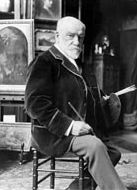BIOGRAPHY - Léon-Joseph-Florentin Bonnat (1833 - 1922)

Léon Bonnat was born in the Basque city of Bayonne, in the far southwestern corner of France, on 20 June 1833. At age 14, Bonnat’s father moved the family to Madrid where he opened a bookstore. The young Bonnat thus began his artistic education at the Academia Real de las Bellas Artes de San Fernando, in the studio of the leading local painter, Federico Madrazo. Naturally, Bonnat also spent many hours studying the collection in the nearby Prado, an opportunity that gave him an in-depth understanding of the Spanish masters who would become a seminal influence on French modernists in the middle of the nineteenth century.
With the death of his father in 1853, the Bonnat family returned to Bayonne, where Léon, now age 20, continued his education at the Ecole de Dessin de Bayonne, under the direction of Romain Julien. A year later, however, he moved to Paris to study with Léon Cogniet at the Ecole des Beaux-Arts. It is interesting to note that the City of Bayonne helped finance this venture with a stipend of 1500 francs in 1854, and in 1857, provided an additional 1500 francs for Bonnat’s study in Rome.
Bayonne’s faith the young painter was well rewarded. Bonnat made his Salon debut in 1857 with three portraits as well as his submission for the Prix de Rome competition, The Resurrection of Lazarus. Although he placed second in the competition, he was nonetheless able to spend the next three years in Rome, where he absorbed the myriad lessons of Renaissance art. The decisive influence of Michelangelo’s work is evident in Bonnat’s 1859 Salon submission, The Good Samaritan as well as his 1861 entry, Adam and Eve Discovering the Body of Abel. The classical contrapposto, combined with the muscularity and the heroic proportions of the figures, unequivocally demonstrate that Bonnat’s years in Rome were both productive and illuminating for the young painter.
Back in Paris by the early 1860s, Bonnat established himself as a leading academic artist. He was frequently asked to act as a juror for the annual Salon exhibitions, one result of which was his nomination to the Legion of Honor in 1867. In addition, his portraiture was in high demand among the Parisian upper classes as well as among leading intellectuals, scientists and politicians of the time. The high quality of his work was recognized with a Gold Medal at the 1869 Salon.
Flush with his successful career, Bonnat and his friend Jean-Léon Gérôme, left Paris in 1868 for an extended tour of the Middle East, traveling from Jerusalem to Egypt where they could observe the rich life of cultures very different from that of France. The resulting paintings, such as An Egyptian Peasant Woman and Her Child, were exhibited at the Salon of 1870. This image, based on a full-length oil study that Bonnat had developed in Egypt, represented a significant shift away from his earlier historical and biblical paintings. For a brief period in the late 1860s and 1870s, Bonnat often experimented with anecdotal genre paintings, but his success in portraiture soon demanded most of his attention. At the Salon of 1877, his portrait of Lous-Adolphe Thiers, the former president of the Third Republic, was a stellar success; in hindsight, this was singularly poignant because Thiers would die the following September. In addition to literally hundreds of portraits over many decades, Bonnat painted such luminaries as Victor Hugo, Louis Pasteur, and his fellow-artist, Pierre Puvis de Chavannes as well as most of the leading political figures of his day.
Beginning in the 1860s, Bonnat had also earned his living by accepting students into his studio. Gradually, his atelier became one of the most respected among young artists in Paris; such diverse painters as Henri de Toulouse-Lautrec and Georges Braques studied here. It was not surprising, then, that the Ecole des Beaux-Arts asked him to join their ranks in the 1880s.
It was during this decade that Bonnat enjoyed sufficient financial stability to indulge his passion for collecting art, especially drawings. He acquired sketches, drawings and prints by Rembrandt, Poussin, and Watteau as well as many others. Eventually, his collection included drawings and paintings from the best of his students and colleagues as well. Like many collectors, Bonnat not only loved the art he accumulated, but he also hoped to share it with a larger public. To that end, he proposed the idea of building a museum in his native Bayonne that would ultimately house his own collection. With his deep roots in the region, continuing family ties to Bayonne, and undoubtedly a sense of gratitude for the support he’d received as a fledgling painter, Bonnat worked tirelessly at developing the new museum. In 1902, he personally installed a significant portion of his own superlative collection in the new Musée Bonnat.
During his later years, Bonnat continued to paint, teach, and exhibit occasionally at the Salon, but his primary focus was refining his art collection and nurturing the growth of the Musée Bonnat. When he died, at age 89, in 1922, Bonnat’s legacy was that of an educator and curator as well as a respected painter.
Janet Whitmore, Ph.D.
Selected Museum Collections
Cleveland Museum of Art Fine Arts
Museum of San Francisco
Metropolitan Museum of Art, New York
Musée Bonnat, Bayonne, France
Musée d’Orsay, Paris
Les musées de Strasbourg
Museum of Fine Arts, Boston
National Gallery of Art, Washington D. C.
